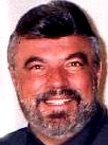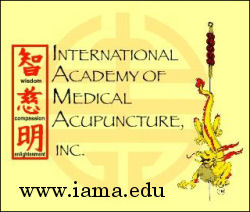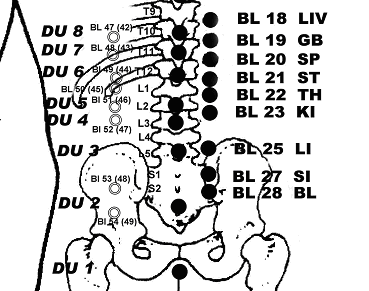Acupuncture & TCM Articles

Acupuncture Articles
by John A. Amaro L.Ac., Dipl.Ac.(NCCAOM), DC
 Dr. Amaro is an internationally known author, lecturer and practitioner beginning his practice of Acupuncture and Chiropractic in 1971. He has led 13 diplomatic Acupuncture study tours of The People's Republic of China escorting more than 500 doctors and practitioners. He has personally studied Acupuncture in nine separate Asian nations. Dr. Amaro is an internationally known author, lecturer and practitioner beginning his practice of Acupuncture and Chiropractic in 1971. He has led 13 diplomatic Acupuncture study tours of The People's Republic of China escorting more than 500 doctors and practitioners. He has personally studied Acupuncture in nine separate Asian nations.
He has received Certification in Acupuncture through the Columbia Institute of Chiropractic in 1973. This was one of the first Acupuncture postgraduate education programs for physicians in North America commencing in 1972.
He has been certified by the Waseda Acupuncture College in Tokyo, Japan in 1974 and graduated from the Chinese Medical Institute, Kowloon, China in 1976. He had previously taken postgraduate studies at the Tai Chung Medical School Taipei, China 1973.
The Low Back thru Asian Eyes
John A. Amaro L.Ac., Dipl.Ac.(NCCAOM), DC
When one considers the fact besides the common cold, more people worldwide and in particular contemporary Western nations, seek a doctors care for lower back pain than the combined total of all other health conditions. It would then stand to reason since the illustration shown here in FIGURE A. are obviously classic local acupuncture (meridian acu-therapy) points found in the low back region, than these points would be without question the most significant local points for the treatment of the number one health condition world wide.
A review of the points in FIGURE A and utilization of just a few of the ones shown, will elicit incredible clinical response in low back pain in the majority of cases. There are additional points which are legendary for low back pain which are not found directly in the lumbar region however to the veteran practitioner as well as the uninitiated the local points illustrated here when stimulated by a variety of physiotherapy means or acupuncture needles can and do illicit impressive response.
The graphic of the acupuncture points of the lumbar region (FIGURE A) is one which you will definitely want to clip and save for further review. The information here is way to important to do otherwise.
Virtually every point illustrated will have a specific effect on lumbalgia, however, BL23, BL25,
Bl 27, BL28, BL52 (47), DU (GV) 2, 3, 4, and 5 are well known for their success in low back pain.
The “DU’ meridian otherwise known as Governing Vessel (GV is a mid line spinal meridian running from the perineum over the spinous processes coursing over the head and ending just under the upper lip between the front two teeth. On this meridian we will find some of the most powerful acupuncture points on the body for a variety of conditions, other than the obvious low back pain.
DU2 Expels interior Wind, strengthens the low back and calms spasms and convulsions
DU3 Below the fourth lumbar, tonifies Yang, and strengthens the lower back and legs
DU4 Gate of Life below the spinous of the second lumbar, nourishes the original Chi, tonifies kidney yang, known as the Ming Men, Gate of Vitality, strengthens the lower back.
DU 5 Below the first lumbar spinous, pain and stiffness of the low back, diarrhea and indigestion.
DU6 Below the eleventh spinous, historic area of chiropractic application according to Palmer
DU7 Below the tenth thoracic spinous, epigastric pain, pain and stiffness of lumbar spine.
DU8 Below the ninth thoracic spinous, expels interior Wind and relaxes tendons, sinews.
All of the acupuncture points beginning with BL18 and progressing thru BL 28 are 1.5 tsun or two fingers breadth bilateral to the midline corresponding to the DU (GV) meridian. Each of these points are named after their specific association thus “associated’ (shu) points. The names of the association are by abbreviation the neophyte will just need to use a slight bit of imagination to understand their significance. BL19 between T10 and T11 is associated with the GB or “Gallbladder’. Knowledge of the working mechanism of the Gallbladder meridian from an acu-practic standpoint will open up an entirely new world of healing. BL19 specifically relaxes the diaphragm therefore it is used for chronic hiccough or anytime the diaphragm is involved. It also is known to pacify the Stomach. For example the Liver associated point BL 18 between T9-T10 has a very strong significance on the eyes as well as muscles, tendons and ligaments. This point moves stagnant Chi in addition to resolving Damp Heat and expelling Wind.
The two points known as BL 20 and BL21 specifically associated with the Spleen and Stomach respectively are classic points to resolve musculo-skeletal conditions as a result of Dampness. They are located opposite of the lower spinous of the 11th and 12th thoracic vertebrae. This is a very historic area of the body as it along with DU 6 and DU7 is the area D.D. Palmer referred to as “Kidney’ place which was an area which was adjusted in every condition regardless of what the diagnosis was. It corresponds to the “Earth’ element in acupuncture and an area of extreme significance. I can be so bold as to say, every D.C. should consider some type of stimulus action on this area of points on every patient who visits the office for care.
The point known as BL22 or associated point to the Triple Heater (San Jiao) meridian is a classic healing point. It is located two fingers breadth opposite of the lower border of the spinous of the first lumbar. This point along with BL 25 (Large Intestine) and BL 27(Small Intestine) will have startling effects on gastrointestinal dysfunction to include colitis, diverticulosis, Chrohns etc.
The Kidney associated point namely BL23 just opposite the lower spinous of L2 is one of the most known points on the body it effects the entire Kidney network to include bone, marrow, ears and Kidney essence. It has a very strong effect on lumbar pain, tinnitus, dizziness, deafness, edema and asthma. It is a very significant point. The last associated point is BL28 opposite the second sacral foramen. It is extremely significant for regulating the bladder, opening water passages affected by the lower burner of the Triple Heater. It strengthens the back and knee and has a very strong effect on pain in general. It has a very close interrelationship with the Atlas vertebrae.
The BL points which are located another 1.5 tsun lateral to the associated BL points or four finger breadths from the DU (GV) are extremely significant in an acupuncture practice.
These points seem to be overlooked far too often in difference to the ones previously discussed. The points of the second channel have two distinct numbering sequences which are universally accepted, however in the US we have seen a gradual take over of the system which begins at the top point of the outer channel as BL41 as opposed to BL36 as known by two generations of practitioners over the last 30 years. For convenience sake I have identified the points of the lower back outer channel by both numbering systems. The point known as BL52 (47 on older charts), is a very significant point which is in line with BL 23 and DU 4 which is just under the spinous of the second lumbar vertebrae. It is known to strengthen the lower back, strengthens the Kidney and affects will power, thus its name Zhishi (Will Power Room). BL51 (46) just above BL52 (47) is known to regulate the TH meridian ensuring smooth spreading of TH chi through the heart and upper burner. Subluxation at this point is critical to the function of the body.
BL 47 (42) at the lower border of the ninth thoracic spinous, is significant in that it regulates the Chi of the Liver and has strong healing factors with the Spleen and Stomach. BL 49 (44) is specific to affect the Spleen and known to stimulate both memory and concentration. It is located just below the eleventh thoracic spinous. BL53 (48) is an extremely vital point for bladder function as seen in its name Baohuang (Bladder Vital). This point is 3 tsun or four finger breadth bilateral to the second sacral foramen. This point is just opposite BL 28 which is the associated point for the Bladder.

Examine carefully the illustration as shown in FIGURE A. These points which have such spectacular significance are something that every D.C. every day are in intimate contact with. Appreciating their presence and understanding their importance will serve the practitioner and patient very well. General stimulation with a mechanical non-invasive stimulation device known as a teishein, a simple piezo stimulator and of course one of the quickest, easiest and most effective is a 5mw 635nm laser pen which is an ideal way to stimulate acupoints. These are readily available and very inexpensive. Obviously needles are a phenomenal way to stimulate points; however the meridian acu-practic approach utilizing a host of non-invasive means is of great clinical significance. Keep this graphic in a convenient location to refer to often. If you are typical, you too will see some spectacular response. Drop me a note of your success, Best Wishes for a fantastic 2005.
|
